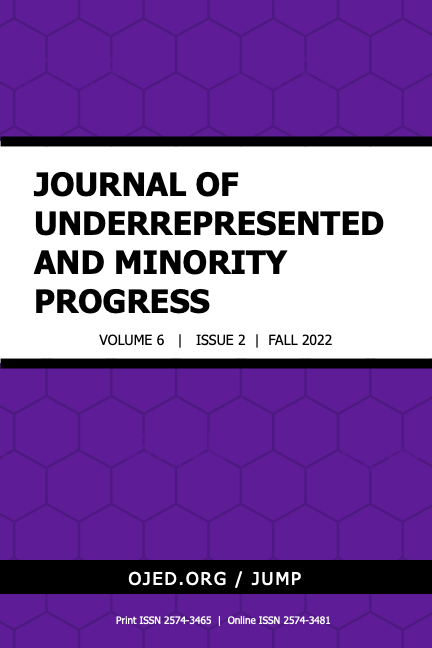U.S. Department of Education Data Document a Declining 17-Year Trend in Black College Student Graduation Rates
DOI:
https://doi.org/10.32674/jump.v6i2.4438Keywords:
graduation rates, national graduation trends, black and white graduation rates, six-year graduation ratesAbstract
The purpose of this study was to conduct the largest (2002-2018) longitudinal analysis and comparison of Black and White college student 6-year graduation rates. Data were obtained from the U.S. Department of Education, National Center for Education Statistics, Integrated Postsecondary Education Data System (IPEDS) for 17 cohorts (1996-2002 to 2012-2018) of Black and White students. Regression analyses confirmed: (1) a statistically significant negative linear trend for Black students, (2) a statistically significant positive linear trend for White Students, and (3) statistically significant differences between the Black and White student regression lines for both the y-intercepts and slopes. In addition, adverse impact, using the EEOC’s “4/5ths rule” was documented for Black students, as compared to White students, in all 17 cohorts.
References
Astin, A.W., Tsui, L., & Avalos, J. (1996) Degree Attainment Rates at American Colleges and Universities: Effects of Race, Gender, and Institutional Type, Higher Education Research Institute, University of California, Los Angeles.
Berkner, L., He, S., & Cataldi, E. F., Knepper, P. (2002), Descriptive Summary of 1995-96 Beginning Postsecondary Students: Six Years Later. (NCES 2003-151). U.S. Department of Education, National Center for Education Statistics, Washington, D.C. Descriptive Summary of 1995–96 Beginning Postsecondary Students: Six Years Later (ed.gov).
Cook, B. & Pullaro, N. (2010) College Graduation Rates: Behind the Numbers, American Council on Education. Washington D.C., September, 2010. College-Graduation-Rates-Behind-the-Numbers.pdf (acenet.edu).
Dey, E. L. & Astin, A.W. (1993) Statistical Alternatives for Studying College Student Retention: A Comparative Analysis of Logit, Probit, and Linear Regression. Research in Higher Education, 43 (1), 83-114. Statistical Alternatives for Studying College Student Retention: A Comparative Analysis of Logit, Probit, and Linear Regression on JSTOR.
Eberle-Sudre, K., Welch, M. & Nichols, A.H. (2016) Rising Tide: Do College Graduation Rate Gains Benefit All Students? The Education Trust, December 2015. Copy/type link into web browser: https://edtrust.org/resource/rising-tide/
Equal Employment Opportunity Commission, Civil Service Commission, Department of Labor, and Department of Justice. (1978) Adoption by Four Agencies of Uniform Guidelines on Employee Selection Procedures. 43 Federal Register, 38, 290-315. 58846NCJRS.pdf (ojp.gov).
Gold, L. & Albert, L. (2006), Graduation Rates as a Measure of College Accountability. American Academic 2(1), 89-106. Graduation Rates as a Measure of College Accountability (shawnee.edu).
Hobson, C. J., Szostek, J., & Griffin, A. (2020) Adverse Impact in Black Student 6-Year College Graduation Rates, Research in Higher Education Journal, Vol. 39, 1-15. Microsoft Word - 203183 (aabri.com).
Horn, L. & Berger, R., Carroll, C. (2004) College Persistence on the Rise? Changes in 5-Year Degree Completion and Postsecondary Persistence Rates Between 1994-2000. (NCES 2005-156) U. S. Department of Education, National Center for Education Statistics, Washington, D.C. College Persistence on the Rise? Changes in 5-Year Degree Completion and Postsecondary Persistence Rates Between 1994 and 2000 (ed.gov).
Musu-Gillette, L., Robinson, J., McFarland, J., KewalRamani, A., Zhang, A., & Wilkinson – Flicker, S. (2016). Status and Trends in the Education of Racial and Ethnic Groups 2016. (NCES 2016-007). U. S. Department of Education, National Center for Education Statistics, Washington, D.C. Status and Trends in the Education of Racial and Ethnic Groups 2016.
Myers, S.M. & Myers, C.B. (2020) The Impact of Expenditures and Financial Aid on Racial Gaps in Institutional Graduation Rates in the U.S. Journal of Underrepresented and Minority Progress, Vol. (4), Issue 2, 143-164. https://www.ojed.org/index.php/jump/article/download/1841/1148/12635
National Center for Education Statistics. (2019) Digest of Education Statistics. https://nces.ed.gov/programs/digest/current_tables.asp.
Noe, R. A., Hollenbeck, J. R., Gerhart, B., & Wright, P. M. (2020) Fundamentals of Human Resource Management (8th ed.). McGraw-Hill Education.
Nichols, A. H., Eberle-Sudre, K., & Welch, M. (2016) Rising Tide II: Do Black Students Benefit as Grad Rates Increase? The Educational Trust, March 2016. Rising Tide II: Do Black Students Benefit as Grad Rates Increase? - The Education Trust (edtrust.org).
Oseguera, L. (2005-2006) Four and Six-Year Baccalaureate Degree Completion by Institutional Characteristics and Racial/Ethnic Groups. Journal of College Student Retention, Vol 7 (1-2), 19-59. ERIC - EJ757057 - Four and Six-Year Baccalaureate Degree Completion by Institutional Characteristics and Racial/Ethnic Groups, Journal of College Student Retention: Research, Theory & Practice, 2006.
Radford, A. W., Berkner, L., Wheeless, S., & Shepherd, B. (2010). Persistence and Attainment of 2003-04 Beginning Postsecondary Students: After Six Years. U. S. Department of Education, National Center for Education Statistics, Washington, D.C. Persistence and Attainment of 2003–04 Beginning Postsecondary Students: After 6 Years (ed.gov).
Scott, M., Bailey, T., & Kienzl, G. (2006): Relative Success? Determinants of College Graduation Rates in Public and Private Colleges in the U.S. Research in Higher Education, Vol. 47, No. 3, May 2006, 249-279. Relative Success? Determinants of College Graduation Rates in Public and Private Colleges in the U.S. on JSTOR.
Shapiro, D., Dundar, A., Huie, F., Wakhungu, P., Yuan., X., Nathan, A., & Hwang, Y.A. (2017) A National View of Student Attainment Rates by Race and Ethnicity—Fall 2010 Cohort (Signature Report No. 12). Herndon, VA: National Student Clearinghouse Research Center, April 2017. Microsoft Word - Signature12-RaceEthnicity.docx (nscresearchcenter.org).
The Education Trust (2014) The State of Education for African American Students. 30 Jun. 2014. TheStateofEducationforAfricanAmericanStudents_EdTrust_June2014.pdf.
The Journal of Blacks in Higher Education (2006) Black Student College Graduation Rates Remain Low, But Modest Progress Begins to Show. The Journal of Blacks in Higher Education, https://www.jbhe.com/features/50_blackstudent_gradrates.html.
The Journal of Blacks in Higher Education (2018) The Nationwide Racial Gap in College Graduation Rates, The Journal of Blacks in Higher Education, https://www.jbhe.com/2018/01/the-nationwide-racial-gap-in-college-graduation-rates-3/.
Wine, J., Janson, N. & Wheeless, S. (2011) 2004/09 Beginning Postsecondary Students Longitudinal Study (BPS: 04/09) Full-Scale Methodological Report (NCES 2012-246). National Center for Education Statistics, Institute of Educational Sciences, U.S. Department of Education, Washington, D.C. 2004/09 Beginning Postsecondary Students Longitudinal Study (BPS:04/09) Full-scale Methodology Report (ed.gov).
Young Invincibles (2017) Race & Ethnicity as a Barrier to Opportunity: A Blueprint for Higher Education, Young Invincibles. Higher-Education-Equity.pdf (younginvincibles.org).


